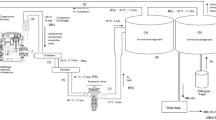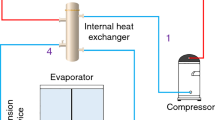Abstract
A study on process alternatives for reducing steam consumption was carried out in a multistage evaporation system of a chlorine–alkali industrial complex. A phenomenological model was developed, based on the mass and energy balances and on gas–liquid equilibrium correlations for the ternary mixture of caustic soda, sodium chloride and water. The design specifications of the plant were adopted as a reference to validate the mathematical model, which comprises 153 nonlinear equations. Different process conditions were simulated by taking into account the most important process variables and their effect on steam consumption. Differently from previously published studies, in which the conservation laws are mainly focused on the heat exchangers and their optimization, the present study considers the whole multistage evaporation unit. The model also enabled to evaluate the effect of changes in the plant configuration, either by considering a side product stream at a specified concentration, designated to another production unit in the industrial complex, or by including mechanical vapor recompression, which has proven to be a better solution to reduce steam consumption from the energy and exergy points of view. Results indicate an expressive decrease in steam consumption to around 1% of the original configuration. Moreover, from the exergy perspective, if the power generation is considered, the MVR is a better choice from the energy and exergy point of view.
Similar content being viewed by others
Abbreviations
- b :
-
Specific exergy (kJ/kg)
- B :
-
Exergy flow rate (kW)
- B :
-
Exergy of the control volume (kJ)
- BPE:
-
Boiling point elevations (°C)
- C :
-
Mass concentration (%)
- c :
-
Specific heat (kJ/kg K)
- h :
-
Specific enthalpy (kJ/kg)
- H :
-
Enthalpy flow rate (kW)
- P :
-
Pressure (kPa)
- Q :
-
Heat transfer rate (kW)
- s :
-
Specific entropy (kJ/kg K)
- T :
-
Temperature (°C/K)
- v :
-
Specific volume (m3/kg)
- W :
-
Performed power (kW)
- x :
-
Mass fraction (kgsubstane/kgsolution)
- y :
-
Molar fraction (kmolsubstance/kmolsolution)
- γ :
-
Activity coefficient
- η :
-
Efficiency
- 0:
-
Environment
- d:
-
Destroyed
- Cool:
-
Cooling process
- ch:
-
Chemical
- in:
-
Stream inside the control volume
- MVR:
-
Mechanical vapor recompression
- out:
-
Stream outside the control volume
- sol:
-
Solution
- MVR:
-
Mechanical vapor recompression
- TVR:
-
Thermal vapor recompression
- SEC:
-
Specific energy consumption
References
Pfisterer F, Meissner D (1993) Ullmann’s, encyclopedia of industrial chemistry, vol A24. VCH Publishers, Weinheim
Rutherford J, Ver Hoeve RW (1984) U.S. Patent 4,459,188. U.S. Patent and Trademark Office, Washington
Shah DJ, Bhagchandani CG (2012) Design, modelling and simulation of multiple effect evaporator. Int J Sci Eng Technol 1(3):01–05
Druetta P, Aguirre P, Mussati S (2013) Optimization of multi-effect evaporation desalination plants. Desalination 311:1–15
Gautami G, Khanam S (2012) Selection of optimum configuration for multiple effect evaporator system. Desalination 288:16–23
Mady CEK, Jardin RN Jr, Oliveira S Jr (2015) Is MVR an efficient alternative to optimize the energy use in an evaporation unit of electrolytic caustic NaOH production? An exergy approach to the diaphragm arrangement. In: Proceedings of ECOS 2015—the 28th international conference on efficiency, cost, optimization, simulation and environmental impact of energy systems, Pau, France
Le Cao Nhien GK, Andika R, Husnil YA, Lee M (2014) Application of mechanical vapor recompression to acetone–methanol separation. Int J Chem Eng Appl 5(3):216–218
Ettouney H (2006) Design of single-effect mechanical vapor compression. Desalination 190(1):1–15
Al-Juwayhel F, El-Dessouky H, Ettouney H (1997) Analysis of single-effect evaporator desalination systems combined with vapor compression heat pumps. Desalination 114(3):253–275
Pellegrini LF, Oliveira S Jr (2006) Exergy analysis of different configurations of multiple-effect evaporators in sugarcane mills. In: Proceedings of the 11th Brazilian Congress of Thermal Sciences and Engineering, Curitiba, Brazil
Ayangbile WO, Okeke EO, Beveridge GSG (1984) Generalised steady-state cascade simulation algorithm in multiple-effect evaporation. Comput Chem Eng 8(3):235–242
Zain O, Kumar S (1996) Simulation of a multiple effect evaporator for concentrating caustic NaOH solution-computational aspects. J Chem Eng Jpn 29(5):889–893
Jyoti G, Khanam S (2014) Simulation of heat integrated multiple effect evaporator system. Int J Therm Sci 76:110–117
Khademi MH, Rahimpour MR, Jahanmiri A (2009) Simulation and optimization of a six-effect evaporator in a desalination process. Chem Eng Process 48(1):339–347
Sayyaadi H, Saffari A (2010) Thermoeconomic optimization of multi effect distillation desalination systems. Appl Energy 87(4):1122–1133
Bapat SM, Majali VS, Ravindranath G (2013) Exergetic evaluation and comparison of quintuple effect evaporation units in Indian sugar industries. Int J Energy Res 37(12):1415–1427
Hamed OA, Zamamiri AM, Aly S, Lior N (1996) Thermal performance and exergy analysis of a thermal vapor compression desalination system. Energy Convers Manag 37(4):379–387
Sogut Z, Ilten N, Oktay Z (2010) Energetic and exergetic performance evaluation of the quadruple-effect evaporator unit in tomato paste production. Energy 35(9):3821–3826
Hanshika C, Jeonga H, Jeongb KW, Choi S (2016) Improved productivity of the MSF (multi-stage flashing) desalination plant by increasing the TBT (top brine temperature). Energy 107:683–692
Soufiyan MM, Dadak A, Hosseini SS, Nasiri F, Dowlati M, Tahmasebi M, Aghbashlo M (2016) Comprehensive exergy analysis of a commercial tomato paste plant with a double-effect evaporator. Energy 111:910–922
Dowlati M, Aghbashlo M, Soufiyan MM (2017) Exergetic performance analysis of an ice-cream manufacturing plant: a comprehensive survey. Energy 123:445–459
Soufiyan MM, Aghbashlo M, Mobli H (2017) Exergetic performance assessment of a long-life milk processing plant: a comprehensive survey. J Clean Prod 140:590–607
Klein SA (2014) Engineering equation solver (EES). F-Chart Software, Madison
Szargut J, Morris DR, Steward FR (1988) Exergy analysis of thermal, chemical, and metallurgical processes. Hemisphere Publishing, Nova York
Campbell AN, Bhatnagar ON (1984) Osmotic and activity coefficients of sodium hydroxide in water from 150 to 250°C. J Chem Eng Data 29:166–168
Pitzer KS, Pelper JC, Busey RH (1984) Thermodynamic properties of aqueous sodium chloride solutions. J Phys Chem Ref Data 13(1):1–102
Flórez-Orrego D, Silva JA, Oliveira SD Jr (2014) Renewable and non-renewable exergy cost and specific CO2 emission of electricity generation: the Brazilian case. Energy Convers Manag 85:619–629
Empresa de Pesquisa Energética (EPE) (2015) Brazilian Energy Balance 2015: year 2014. Empresa de Pesquisa Energética (EPE), Rio de Janeiro
Funding
Funding was provided by Unipar Carbocloro.
Author information
Authors and Affiliations
Corresponding author
Additional information
Technical Editor: Jose A. R. Parise.
Rights and permissions
About this article
Cite this article
Keutenedjian Mady, C.E., Bresciani, A.E., Paiva, J.L. et al. Thermodynamic assessment of MVR implementation in multistage evaporation plants. J Braz. Soc. Mech. Sci. Eng. 40, 395 (2018). https://doi.org/10.1007/s40430-018-1319-x
Received:
Accepted:
Published:
DOI: https://doi.org/10.1007/s40430-018-1319-x












